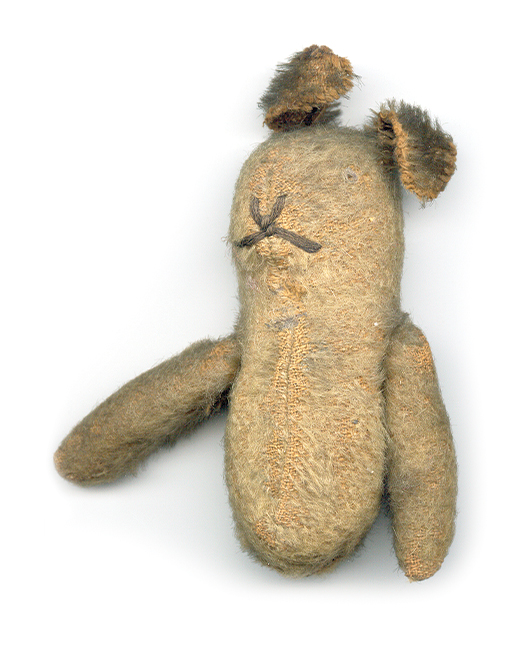A small teddy bear that would not cover the palm of an adult’s hand is one of the more touching artifacts in a new permanent exhibit at the Canadian War Museum in Ottawa.
The bear belonged to 10-year-old Aileen Rogers when she sent it to her father, Lieutenant Lawrence Browning Rogers, to keep him safe while he was fighting overseas during the First World War. The threadbare toy was found in his pocket after he was killed at Passchendaele in 1917.
The 185-square-metre exhibit entitled The Home Front, 1917, part of the museum’s permanent First World War gallery, looks at the war’s impact and the hardships it brought for those who remained in Canada. The first part of the exhibit uses letters, postcards and toys to tell of the separation of families and sweethearts. The second part looks at the crisis brought on in 1917 by conscription.
The teddy bear and the uniform worn by Rogers tell of family life in the period. Many of the artifacts illustrate the patriotism of the time. There are photos of children wearing military style clothing and books published for young people such as the series The Children’s Story of the War. A poster encourages parents to teach their children to collect thrift stamps.
There are recordings and sheet music of patriotic songs. A segment of the Charles Chaplin movie, Shoulder Arms, shows the importance of mail to those serving in the trenches.
Although Prime Minister Sir Robert Borden had ruled out conscription in 1916, he changed his mind as the number of volunteers declined and casualties increased (“Borden’s Great Gift,” March/April). Conscription was an acrimonious issue and became the focus of the 1917 general election.
“We often think of the conscription crisis as being one of English against French, those for conscription and those against,” said Andrew Burtch, acting director of research, in opening the exhibit on Feb. 19. “But it was not that simple. We saw farmers from Saskatchewan marching on Ottawa because they had been promised that their sons would be exempted.” The issue sparked a general strike in British Columbia and a riot in Quebec City.
Once conscription became law, tribunals were established, usually with two respected members of the community hearing applications for exemptions from military service. In an interactive part of the display, visitors can hear true, individual applications for exemption and then have a chance to choose whether they would accept or reject the exemption. After making a choice, a screen comes up with the final decision. For example, George Geoffrey of Toronto argued that his work as a schoolteacher was of national importance. The judge agreed, ruling, “It is absolutely necessary that competent teachers be held to their important post of teaching the young mind.”
The exhibit looks at other aspects of the home front that had a lasting impact on Canadian society, such as extending the vote in the 1917 general election to all members of the Canadian Expeditionary Force and to soldiers’ wives, mothers, daughters and sisters. Income tax was also introduced—although it was supposed to be a temporary measure.
“It’s very hard to find objects for the exhibit because the families did not keep them as much as they kept letters from overseas or objects that belonged to soldiers,” said the museum’s First World War historian and curator Mélanie Morin-Pelletier. “But, in the end, we do have some very powerful stories to present to visitors.”
Advertisement























